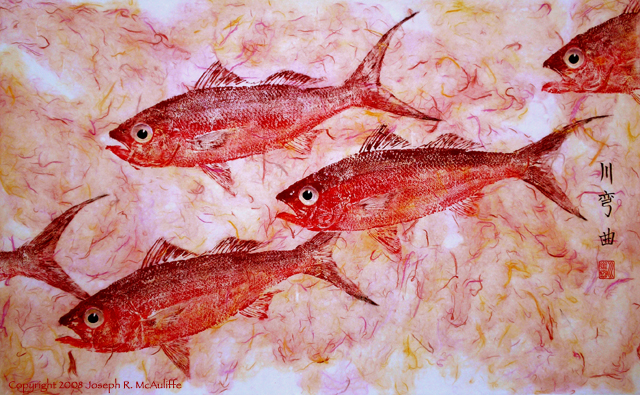
These are flame snappers (Etelis coruscans), also known as long-tailed red snappers. The flame snapper inhabits the Indian and Pacific Oceans and is found from eastern Africa to the Hawaiian Islands and from southern Japan to northern Australia. They are deep-water fishes and are found at depths of 250 to over 1000 feet. In Honolulu fish markets, they are most commonly called onaga; they also have the native Hawaiian name ula’ula kao’e.
Beginning in the 1980s, Hawaiian fishermen noticed that they were fishing more and more but catching less and less deep-water fish like the flame snapper. Many deepwater fishes like the flame snapper tend to grow slowly and take a long time to reach reproductive maturity. Those characteristics make them particularly susceptible to over-fishing. Declining average size of the flame snappers that were caught and an increase in the percentage of the catch that had not yet reached sexual maturity provided clear evidence that harvest rates exceeded the populations’ capacities for replenishment.
One of the obstacles to the implementation of measures to conserve this and other depleted deepwater fishes has been a lack of knowledge about the kinds of habitat they require. These fish live at depths well beyond the range of SCUBA diving, therefore, there were no direct observations of these fish in their natural habitat. In order to solve this problem, researchers in Hawaii used deep-sea submersibles, capable of diving to greater than 6000 feet depths in order to study and document the habitats used by the flame snapper and other depleted species. Their studies showed that these fishes almost exclusively use rocky habitats composed of ancient reefs formed by coral long ago. Although the deeply submerged reefs lacked living corals, the hard substrate was essential for these fishes. More importantly, small crevices, nooks and crannies within the coral rock harbored abundant prey and also provided protections for the young, immature individuals of the larger predaceous fish. If rocky locations lacked the shelter of small crevices and voids, the sites also lacked potential prey and larger predators such as flame snappers. Identifying habitat features that are required by these fish is a necessary step for designating potential marine sanctuary (no-fishing) areas. Such areas have proven valuable in recovering stocks of fish species that had been previously over-exploited.
Size: 36 x 24 inches (2007)
Return to Gallery 3.